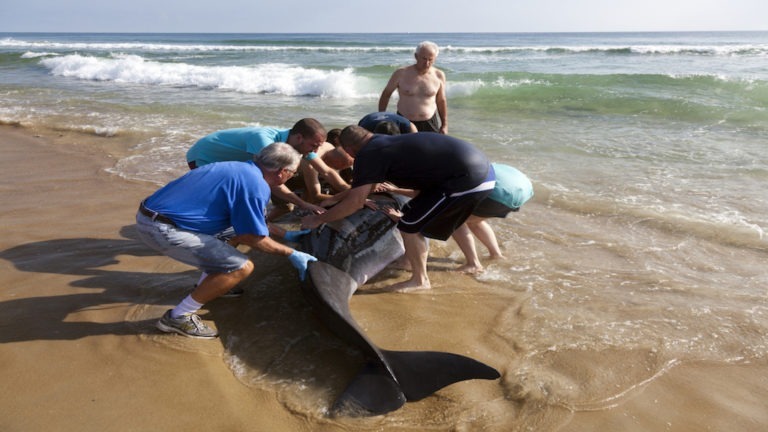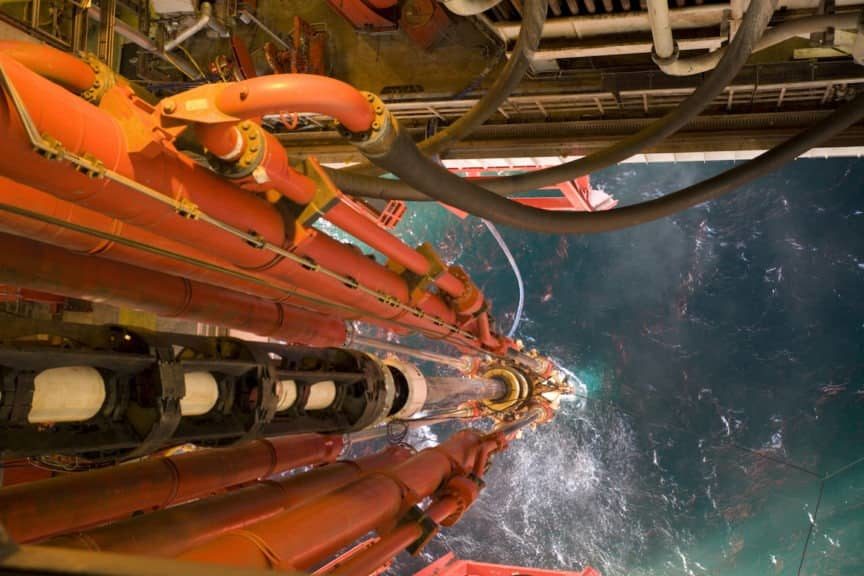Ocean Noise Pollution From Drilling and Sonar Is Beaching Whales

150 short-finned pilot whales recently stranded on a beach in western Australia, resulting in the death of all but five of them. The exact reason for the whale’s beaching is unknown, but it comes after New Zealand’s largest stranding around the same time last year, when over 600 pilot whales washed ashore.
The recent beaching occurred in Hamelin Bay on Mar. 23, but by the time the whales were spotted it was too late to save them, as they had beached themselves overnight.
It’s common for whales to beach if they are sick, old, or injured. Cetaceans often become stranded this time of year as they travel north from feeding grounds in the Arctic, though a number this large is unusual.
Certain areas have been known to be hotspots for mass whale strandings, such as the Farewell Spit off the northern tip of New Zealand’s South Island. Here, a gradient of progressively shallow waters leads into a sand bar, often confusing marine mammals’ echolocation until it’s too late.
But when it comes to large-scale beachings such as these, the concern is often that there may be anthropogenic factors at play.
Noise Pollution and Whales
Though there could be a number of factors that contributed to the recent pilot whale incident, noise pollution has been recognized as one of the biggest factors in previous cetacean strandings. These highly sensitive animals become confused or physically injured by loud, high-powered sonar from naval ships, military exercises, and oil exploration.
The U.S. Navy has been brought to court in the past for its use of incredibly loud sonar pulses found to be in violation of the National Environmental Policy Act. After a ruling from the 9th Circuit Court of Appeals, it was decided the Navy’s use of ultra-loud sonar wasn’t safe for marine mammals and could not be used during peacetime.
Unfortunately, defining peacetime can be somewhat difficult. With so many military conflicts, the line between peace and war can get blurry.
So how loud is this military-grade sonar that it’s confusing the most intelligent creatures in the ocean?
The sonar used by naval ships can reach sound levels upwards of 200 decibels, loud enough to rupture human lungs. These soundwaves can even retain 140 decibels up to 300 miles away from where they were emitted – that’s roughly the same decibel level as a rock concert.
Adding insult to injury, sound travels faster and louder underwater, due to the higher density of water particles compared to air. In fact, noise can travel up to four times faster and further in water. This may seem counterintuitive to us because our ears have adapted to hearing above water. But for whales and dolphins whose ears are highly sensitive and adapted for underwater listening, these low frequency waves can be picked up from a radius of hundreds of miles.

When marine mammals are subjected to this kind of noise, their first reaction is to swim away from it. Often, the animals will surface from depths of up to 1000 ft., giving them the bends just like humans.
This decompression sickness has been observed in cetaceans that have surfaced quickly, with eyes and ears bleeding. In some cases, the noise is so harmful it can even blow out their ear canals. The animals become disoriented and wind up beached, typically resulting in their death.
In addition to this piercing pain marine mammals experience from ultra-loud sonar, it’s believed that mid-frequency sonar may mimic the echolocation used by cetacean predators, such as killer whales – another factor that can result in strandings.
Short-finned pilot whales are the most susceptible to mass strandings as they are very social animals that travel and fish in large pods. Beaked whales are another vulnerable group that have been involved in studies proving naval sonar does, in fact, harm them.
But while the U.S. has agreed to limit its use of sonar, activity from foreign navies hasn’t necessarily been put under the same scrutiny. In areas with high naval traffic like the South China Sea, military-grade sonar is probably used a lot more often than one would imagine.
Ocean Noise Pollution Effects from Oil Exploration
Air guns are a common tool used by companies exploring for oil reserves, sending pulses of sound deep below the surface of the ocean. This process, known as seismic surveying, is incredibly loud and can resonate up to several thousand miles away.
Exploratory blasts have to resonate incredibly deep, in order to penetrate beneath the ocean floor, and are emitted for weeks or even months at a time, producing effects similar to naval sonar.

Seismic surveying also scares away the fish. This creates a problem for both fisherman and cetaceans, who rely on fish in the area as a food source.
Over the years, whales have had to adapt to this noise pollution by using higher frequencies to communicate with each other, almost as if they have to yell over the noise to be heard. And this underwater yelling is among the many signs that cetaceans are stressed out by the extreme dissonance.
And it’s not just the sound emitted from oil exploration and sonar. Noise pollution from ship engines and propellers is equally disruptive to animal communication and echolocation. Meanwhile, shipping traffic has been exponentially increasing every decade, adding more cacophony to already loud oceans.
Some countries have taken steps to reduce the amount of seismic surveying and limit the harmful impacts it can have on marine populations. But at the same time, exploration has been opened up in new areas as our thirst for oil continues without reluctance.
Unless we spread awareness and continue to push back against the massive industries and military operations harming these animals, we may ironically drown these beautiful creatures – with noise.
How Cryptocurrencies Like Bitcoin Can Democratize Money and Society

As cryptocurrencies like Bitcoin break new records seemingly every day, could this lead to a financial and cultural revolution? Or are we not quite there yet?
Cryptocurrencies have recently gained popularity as an alternative to conventional monetary systems. Blockchain is a system in which a record of transactions made in Bitcoin and other cryptocurrencies are maintained across multiple computers that are linked in a peer-to-peer network. Cryptocurrency has no centralized bank controlling the flow of money, but rather a decentralized system controlled by algorithms.
Crypto has been hailed as a way to democratize finances for all, not just wealthy elites. But with the rise in popularity, what are the potential pitfalls of these online currencies?
“Blockchain is a way of digitally marking the development and moving around of this money—you’re making sure that it can’t be counterfeited. They do it in such a way that it’s anonymous and decentralized, but secure,” Zeus Yiamouyiannis, author of Transforming Economy, said.
“The current monetary system can be manipulated; the supply can be manipulated to benefit very few people over the many. As we’ve been seeing over the past few decades, the same pattern keeps emerging and it’s growing, and that is greater and greater gambling by the big boys, to the point where they inherently fail through their greed. And guess who bails them out 100 percent of the time? The little guy who had absolutely nothing to do with it,” Yiamouyiannis said.




































